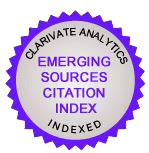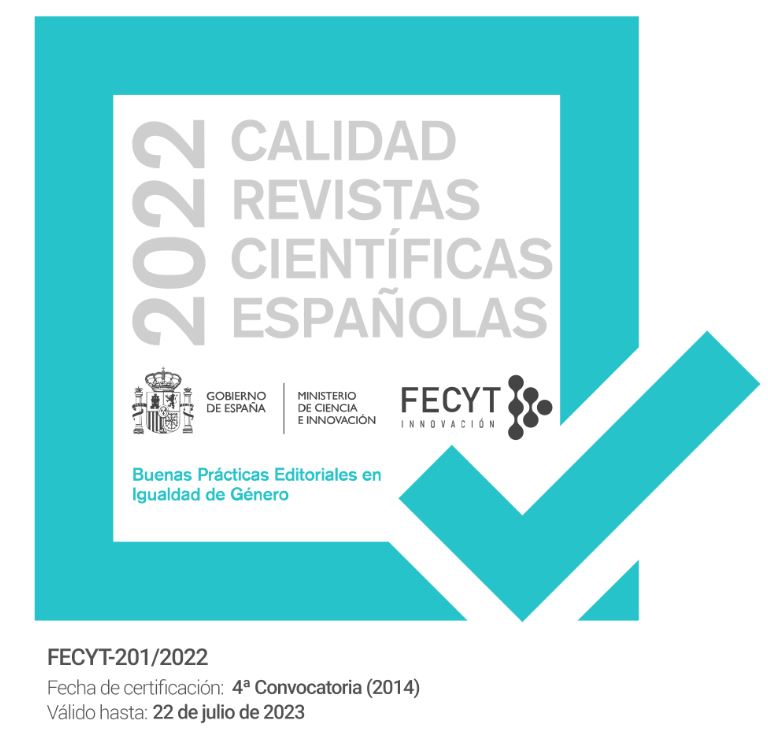VARIABLES DEMOGRÁFICAS Y OCUPACIONALES SOBRE LA AUTOEFICACIA DE LOS DOCENTES DE EDUCACIÓN ESPECIAL EN GRECIA
DOI:
https://doi.org/10.30827/eticanet.v25i1.31758Keywords:
autoeficacia, docentes de educación especial, educación inclusiva, capacitación docenteAbstract
Teacher self-efficacy is an important aspect of successful pedagogical practices in special education where students with special educational needs can benefit from teachers’ improved cognitions and internal reflection. This quantitative study examined the levels of self-reported self-efficacy of 600 special education teachers in Greece and the extent to which self-efficacy differs significantly according to demographic and occupational variables. Through the use of the short version Teacher Sense of Efficacy Scale (TSES), teachers reported a high sense of self-efficacy, and the demographic and work characteristics of the sample significantly differentiated self-efficacy as it is reflected on the score of the three subscales of classroom management, involving students in the educational process and teaching strategies. Findings were congruent with most studies, indicating that special education teachers may have different personal characteristics compared to teachers of inclusive education.
Downloads
References
Agaliotis, I., & Kalyva, E. (2011). A survey of Greek general and special education teachers’ perceptions regarding the role of the special needs coordinator: Implications for educational policy on inclusion and teacher education. Teaching and teacher education, 27(3), 543-551. https://doi.org/10.1016/j.tate.2010.10.008 DOI: https://doi.org/10.1016/j.tate.2010.10.008
Akdemir, O. (2018). An investigation of the relationship between prospective teachers’ self-efficacy beliefs and their attitudes towards teaching profession. Journal of Education and e-Learning Research, 5(3), 157-164. https://doi.org/0.20448/journal.509.2018.53.157.164 DOI: https://doi.org/10.20448/journal.509.2018.53.157.164
Antoniou, A., Geralexis, I. & Charitaki, G. (2017). Special educators’ teaching self-efficacy determination: A quantitative approach. Psychology, 8, 1642-1656. https://doi.org/10.4236/psych.2017.811108 DOI: https://doi.org/10.4236/psych.2017.811108
Athanasiadis, I., & Delli, C K S. (2010). Training and motivations of special education teachers in Greece. Review of European studies, 2(1). https://doi.org/10.5539/res.v2n1p96 DOI: https://doi.org/10.5539/res.v2n1p96
Chambers, D., & Forlin, C. (2021). An historical review from exclusion to inclusion in Western Australia across the past five decades: What have we learnt? Education Sciences, 11(3), 1-15, https://doi.org/10.3390/educsci11030119 DOI: https://doi.org/10.3390/educsci11030119
Chao, C. N. C., Sze, W., Chow, E., Forlin, C., & Hod, F. C. (2017). Improving teachers’ self-efficacy in applying teaching and learning strategies and classroom management to students with special education needs in Hong Kong. Teaching and Teacher Education, 66, 360-369. https://doi.org/10.1016/j.tate.2017.05.004 DOI: https://doi.org/10.1016/j.tate.2017.05.004
Chesnut, S. R., & Burley, H. (2015). Self-efficacy as a predictor of commitment to the teaching profession: A meta-analysis. Educational Research Review, 15, 1-16. https://doi.org/10.1016/j.edurev.2015.02.001 DOI: https://doi.org/10.1016/j.edurev.2015.02.001
Chin, R., & Lee, B. Y. (2008). Analysis of data. In R. Chin & B. Y. Lee (eds.), Principles and practice of clinical trial medicine (pp. 325-359). Academic Press. DOI: https://doi.org/10.1016/B978-0-12-373695-6.00015-6
Chiner, E., & Cardona, M. C. (2013). Inclusive education in Spain: How do skills, resources, and supports affect regular education teachers perceptions of inclusion? International Journal of Inclusive Education, 17(5), 526–541. https://doi.org/10.1080/13603116.2012.689864 DOI: https://doi.org/10.1080/13603116.2012.689864
Chiner, E., Gómez-Puerta, M., & Cardona-Moltó, M. C. (2022). Digital inclusion in Spanish mainstream and special schools: Teachers’ perceptions of Internet use by students with intellectual disabilities. British Journal of Learning Disabilities, 51(2), 195–204. https://doi.org/10.1111/bld.12503 DOI: https://doi.org/10.1111/bld.12503
Creswell, J. W. (2014). Research design: Qualitative, quantitative, and mixed methods approaches (4th ed.). Sage.
Epstein, A., & Willhite, G. L. (2015). Teacher efficacy in an early childhood professional development school. International Electronic Journal of Elementary Education, 7(2), 189-198. https://www.iejee.com/index.php/IEJEE/article/view/74
Forlin, C., & Chambers, D. (2023). Is a Whole School Approach to Inclusion Really Meeting the Needs of All Learners? Home-Schooling Parents’ Perceptions. Education Sciences, 13(6), 1-12, https://doi.org/10.3390/educsci13060571 DOI: https://doi.org/10.3390/educsci13060571
Loreman, T., Forlin, C., & Sharma, U. (2014). Measuring indicators of inclusive education: A systematic review of the literature. International Perspectives on Inclusive Education, 3, 165–187. https://doi.org/10.1108/S1479-363620140000003024 DOI: https://doi.org/10.1108/S1479-363620140000003024
Mampane, S. T. (2017). Managing the Teaching of Diverse Learners in Inclusive Classes in a South African Context. International Journal of Educational Sciences, 18(1–3), 181–190. https://doi.org/10.1080/09751122.2017.1317169 DOI: https://doi.org/10.1080/09751122.2017.1317169
Materechera, E. K. (2020). Inclusive education: why it poses a dilemma to some teachers. International Journal of Inclusive Education, 24(7), 771–786. https://doi.org/10.1080/13603116.2018.1492640 DOI: https://doi.org/10.1080/13603116.2018.1492640
Mehdinezhad, V. & Mansouri, M. (2016). School principals’ leadership behaviors and its relation with teachers’ sense of self-efficacy. International Journal of Instruction, 9(2), 51-60. http://dx.doi.org/10.12973/iji.2016.924a DOI: https://doi.org/10.12973/iji.2016.924a
Mintz, J., Hick, P., Solomon, Y., Matziari, A., Ó’Murchú, F., Hall, K., Cahill, K., Curtin, C., Anders, J., & Margariti, D. (2020). The reality of reality shock for inclusion: How does teacher attitude, perceived knowledge and self-efficacy in relation to effective inclusion in the classroom change from the pre-service to novice teacher year? Teaching and Teacher Education, 91, 103042. https://doi.org/10.1016/j.tate.2020.103042 DOI: https://doi.org/10.1016/j.tate.2020.103042
Miyauchi, H. (2020). A systematic review on inclusive education of students with visual impairment. Education Sciences, 10(11), 1–15. https://doi.org/10.3390/educsci10110346 DOI: https://doi.org/10.3390/educsci10110346
Papageorgiou, M. (2019). Critical Approaches to Inclusive Education. Universal Review, SSRN Electronic Journal, 8(2), 423-434. https://doi.org/10.2139/ssrn.3339212 DOI: https://doi.org/10.2139/ssrn.3339212
Pappas, M A., Papoutsi, C., & Drigas, A. (2018). Policies, Practices, and Attitudes toward Inclusive Education: The Case of Greece. Social sciences, 7(6), 1-15. https://doi.org/10.3390/socsci7060090 DOI: https://doi.org/10.3390/socsci7060090
Rampasso, I. S., Bertazzoli, R., Dibbern, T., Serafim, M. P., Leal Filho, W., Rojas-Córdova, C., & Anholon, R. (2022). Evaluating research partnerships through ISO 56003 guidelines, RRI concepts, and ex post facto cases. Sustainability, 14, 4186. https://doi.org/10.3390/su14074186 DOI: https://doi.org/10.3390/su14074186
Robson, K. L. (2019). Sociology of education in Canada. Pearson Education.
Shaukat, S., Vishnumolakala, V. R., & Al Bustami, G. (2019). The impact of teachers’ characteristics on their self-efficacy and job satisfaction: A perspective from teachers engaging students with disabilities. Journal of Research in Special Educational Needs, 19(1), 68-76. https://10.1111/1471-3802.12425 DOI: https://doi.org/10.1111/1471-3802.12425
Sullivan-Sego, C., Ro, Y. E., & Park, J. (2016). Including All Learners with Diverse Abilities. Childhood education, 92(2), 134-139. https://doi.org/10.1080/00094056.2016.1150749 DOI: https://doi.org/10.1080/00094056.2016.1150749
Tschannen-Moran, M., & Hoy, A. W. (2001). Teacher efficacy: Capturing an elusive construct. Teaching and Teacher Education, 17(7), 783-805. https://doi.org/10.1016/S0742-051X(01)00036-1 DOI: https://doi.org/10.1016/S0742-051X(01)00036-1
Tsigilis, N., Koustelios, A., & Grammatikopoulos, V. (2010). Psychometric Properties of the Teachers’ Sense of Efficacy Scale Within the Greek Educational Context. Journal of Psychoeducational Assessment, 28(2), 153-162. https://doi.org/10.1177/0734282909342532 DOI: https://doi.org/10.1177/0734282909342532
Üstüner, M. (2017). Personality and attitude towards teaching profession: Mediating role of self-efficacy. Journal of Education and Training Studies, 5(9), 70-82. https://doi.org/10.11114/jets.v5i9.2536 DOI: https://doi.org/10.11114/jets.v5i9.2536
Versland, T. (2018). Principal efficacy: Implications for rural ‘grow your own’ leadership programs. The Rural Educator, 35(1). https://doi.org/10.35608/ruraled.v35i1.361 DOI: https://doi.org/10.35608/ruraled.v35i1.361
Woodcock, S., Sharmab, U., Subban, P., & Hitches, E. (2022). Teacher self-efficacy and inclusive education practices: Rethinking teachers’ engagement with inclusive practices. Teaching and Teacher Education, 117, 103802. https://doi.org/10.1016/j.tate.2022.103802 DOI: https://doi.org/10.1016/j.tate.2022.103802
Wray, E., Sharma, U., & Subban, P. (2022). Factors influencing teacher self-efficacy for inclusive education: A systematic literature review. Teaching and Teacher Education, 117, 103800. https://doi.org/10.1016/j.tate.2022.103800 DOI: https://doi.org/10.1016/j.tate.2022.103800
Downloads
Published
Issue
Section
License
The authors who publish in this journal agree to the following terms: The authors retain the copyright and grant the journal the right to be the first publication of the work as well as licensed under a Creative Commons Attribution License that allows others to share the work with an acknowledgment of the authorship of the work and the initial publication in this magazine. Authors are allowed and encouraged to disseminate their work electronically (for example, in institutional repositories or on their own website) before and during the submission process, as it may lead to productive exchanges as well as further citation. Earliest and greatest of published works (See The Effect of Open Access).













